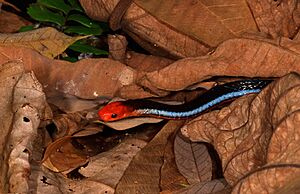Calliophis bivirgatus facts for kids
Quick facts for kids Calliophis bivirgatus |
|
|---|---|
 |
|
| Conservation status | |
| Scientific classification | |
| Genus: |
Calliophis
|
| Species: |
bivirgatus
|
| Synonyms | |
The Calliophis bivirgatus is a type of snake in the Elapidae family. It is usually called the blue coral snake or blue Malayan coral snake. This snake lives naturally in Southeast Asia.
Contents
Where does the blue coral snake live?
This snake lives on land in countries like Brunei, Indonesia, Malaysia, Singapore, Thailand, and Burma (also known as Myanmar). You can find it in places that are about 100 to 1,100 meters (330 to 3,600 feet) above sea level.
There are three main types, or subspecies, of this snake:
- C. b. bivirgatus – found in Indonesia
- C. b. flaviceps – found in Indonesia, Malaysia, Thailand, Singapore, and Burma
- C. b. tetrataenia – found in Indonesia, Malaysia, and Brunei
What does the blue coral snake look like?
This is a medium-sized coral snake with a thin body. An adult snake can grow up to 1.8 meters (about 6 feet) long. It has a bright red head, tail, and belly. Its back is dark blue to black. It usually has a big blue or white stripe along each side of its body.
Young blue coral snakes are sometimes mistaken for the pink-headed reed snake (Calamaria schlegeli). This is because they live in similar places and look a bit alike. However, the reed snake is much smaller, only growing to about 50 centimeters (20 inches) long. The reed snake is not venomous, but the blue coral snake is very dangerous. They also look similar to another venomous snake, the red-headed krait (Bungarus flaviceps).
How does the blue coral snake live?
This snake is not seen very often. It spends some of its time partly underground, hidden in the leaf litter of old and new forests. The blue coral snake mostly eats other snakes.
If it feels threatened, it usually tries to get away quickly. But sometimes, it will stay still and stick its bright red tail straight up. This is a warning sign to tell predators to stay away. It's like saying, "I'm dangerous, don't mess with me!"
Is the blue coral snake venomous?
Yes, the blue coral snake is venomous. Its venom has caused serious effects in humans, though it is rare. This snake has very long venom glands, which can reach up to a quarter of its body length!
The venom contains a special substance called calliotoxin. This toxin can cause very fast paralysis in the animals it preys on. This is especially helpful because the blue coral snake often hunts other venomous snakes. Scientists are also studying this snake's venom because it might be useful for treating long-lasting pain in humans in the future.
See also
- Ophiophagy


